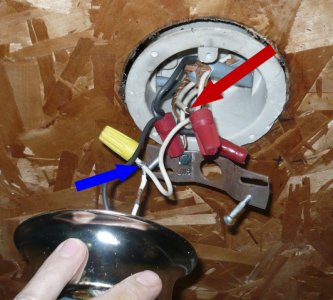Terrible wiring, voltage drop not tripping the breaker is probably an indication of a poor wire connection increasing the resistance as others have indicated. A few notes; Typical current carrying wires "Hot" side for residential AC wiring is always black or red (usually 2nd leg in single phase 240VAC or switched leg in a 3 way switch) insulated wire. White wire is always neutral (unless marked with electrical/colored tape at each end), which is bonded to earth at the main panel only. Green or bare copper wire is always ground. Romex is fine in an enclosed wall or ceiling, I do not see any need/cost for shielded cable if local electrical code does not require it. Romex needs to be secured with manufacturer approved staples (I prefer the plastic ones) at least ever 4 1/2 feet or less, 12" within a box or receptacle when secured, or 8" if not secured at the entry point into the box. An accessible box is needed for any junction.


